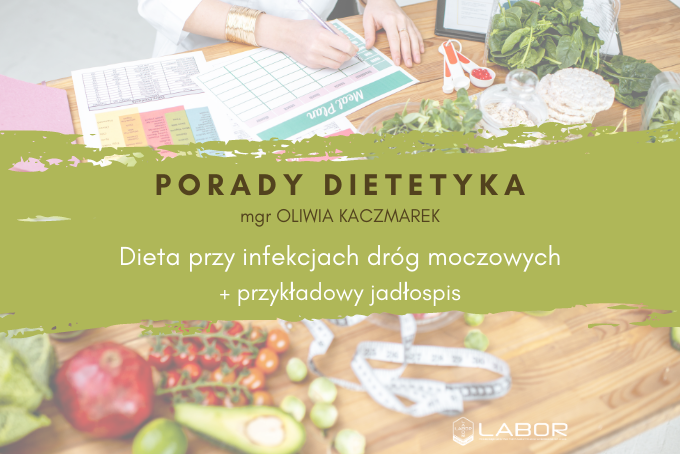Urinary tract inflammation (UTI) is the most common bacterial inflammation in humans. The mechanism of its formation is related to the accumulation of bacteria at the mouth of the urethra and the migration of microorganisms to the urinary tract. Under normal conditions, these pathways are sterile. Infection is most often attributed to Escherichia coli (85%) (coliform bacteria), less frequently to the genus Enterococcus (cocci) or Staphylococcus (staphylococci). Women are more prone to infection than men, mainly due to their anatomical structure, as the urethra in women is on average 4 to 18 cm shorter than in men.
The causes of infection
Infections are favored by improper personal hygiene, difficulty in urinating in pregnant women or as a result of an enlarged prostate in men, using a public swimming pool or toilets, or a decrease in immunity, general weakness, and urine retention in the bladder, because it is a good medium for bacteria. The causes of infections may also be hospitalization and any procedures performed on the urinary tract, such as catheterization.
Symptoms
Urinary tract infections are manifested primarily by increasing pain in the lower abdomen, more frequent urination, burning sensation and discomfort when urinating. The manifestation of inflammation of the urinary tract is often the appearance of fever.
Basic principles of the diet
People at risk of relapse can strengthen the natural defenses of the urinary tract through adequate nutrition. Following a few dietary rules will help you recover faster and also help prevent inflammation of the urinary tract in the future.
In the case of urinary tract infections, the body’s hydration should be improved and a minimum of 2 liters of fluid (30 milliliters for every kilogram of body weight) per day should be provided. Water or herbal teas containing diuretic herbs such as horsetail, nettle or birch leaves are the best choices. The use of diuretic and urinary cleansing herbs can be used in the treatment and prevention of UTIs. The increased amount of fluid increases the amount of urine excreted, and with it, waste products are removed, contributing to the improvement of the body’s condition. Emptying your bladder frequently can also flush the electrolytes out of your body. In such situations, it is recommended to consume a preparation containing salt ions in the form of a drinking solution, e.g. Elektrolity Labor.
In the diet, it is worth taking care of the right amount of vegetables and fruits, which are particularly rich in vitamin C. It is believed that ascorbic acid (i.e. vitamin C) plays an important role in reducing urinary tract infections, increases urine acidity, eliminating pathogens causing infections, because it is acidic. the environment is not a good place to develop them. An example of such a vegetable is parsley, which has been used medicinally for generations. The components of this plant, i.e. essential oils, phytosterols and sugar compounds, contribute, among others, to increasing blood flow through the kidneys, increasing the filtration of urine in the renal glomeruli and acting as an antiseptic in the urinary tract. Other natural sources of vitamin C are paprika, Brussels sprouts, kohlrabi, broccoli, cabbage, kale, cauliflower, eggplant, and green beans. Among fruits, the most vitamin C is found in rosehips, black and red currants, strawberries, kiwi, citrus, gooseberries and raspberries. A unique fruit is cranberry, which has antibacterial properties, which works well in urinary tract infections. Cranberry fruits are rich in polyphenols, especially anthocyanins and procyanides, vitamin C and organic acids such as benzoic, citric and quinic acids. Polyphenols are organic compounds that occur naturally in plants, giving them color and a characteristic tart and bitter taste. Like organic acids, they have a strong antioxidant and bactericidal effect. Cranberry extract not only prevents inflammation of the urinary system, but also speeds up their treatment. Research shows that compounds contained in cranberries (mainly proanthocyanidins) have an antibacterial effect by inhibiting the adhesion of Escherichia coli to epithelial cells and limit the multiplication of bacteria in the urinary tract. [1,2,3,4]
The next appropriate dietary step in the fight against recurrent infections is the consumption of natural probiotics, e.g. yoghurts and kefirs. A special role is assigned to Lactobacillus bacilli, i.e. lactic acid bacteria, which have a beneficial effect on the microflora of the genitourinary system. They inhibit the multiplication and adherence of pathogenic bacteria to the epithelium of the urinary tract, they favorably change the pH of the urinary tract, but also inhibit the growth of most harmful bacteria [5].
Prevention of urinary tract infections is especially important when you have common problems. The best solution is preventive measures. Therefore, maintaining a healthy diet based on the indicated products, leading a healthy and hygienic lifestyle is fundamental in supporting health and well-being. People prone to urinary tract infections can use over-the-counter preparations. An effective dietary supplement is Uroxill, which includes vitamin C and proanthocyanidins, available in the form of capsules or powder sachets. It contains bioactive substances such as natural extracts of parsley, large cranberry and sage, as well as lactic acid bacteria. The use of the preparation will certainly help you deal with the unpleasant symptoms of infection.
Bibliografia
1. Różański H., Charakterystyka najważniejszych urotropica i ich zastosowanie w fitoterapii chorób układu moczoweg, Uniwersytet Medyczny im. K. Marcinkowskiego Zakład Historii Nauk Medycznych, Ośrodek Badawczo-Rozwojowy LNB Poland
2. Bazylko A., Kozłowska-Wojciechowska M., WPŁYW POLIFENOLI Z ŻURAWINY NA ZDROWIE CZŁOWIEKA , CZYNNIKI RYZYKA 4/2007, s.57-61
3. Gryszczyńska A., Żurawina amerykańska (Vaccinium macrocarpon) ? lek na problemy urologiczne, Przegląd Urologiczny Urologia ? nauka i praktyka, 2010/11/5(63), s.31-39
4. Baranowska M., Bartoszek A., Antyoksydacyjne i przeciwdrobnoustrojowe właściwości bioaktywnych fitozwiązków żurawiny, Postepy Hig Med Dosw (online), 2016; 70,s.1460-1468
5. Zwolińska D., Probiotyki w profilaktyce nawracających zakażeń układu moczowego u dzieci, Pediatr Med Rodz 2017, 13 (3), s.335?343
ONE – DAY FOOD 1850 kcal
? The menu is balanced in terms of the amount of protein (15%), fats (30%) and carbohydrates (55%).
? Contains essential vitamins and minerals, including the daily requirement of vitamin C.
Breakfast – Peel the apple and grate it on large meshes.
– Pour olive oil into a hot frying pan, fry the chopped onion. Then add the grated apple and stew for a while.
– Add spices.
– Blend the beans until smooth and mix everything together.
– The paste tastes best when chilled.
Wholemeal bread 70 g (2 slices)
Canned white beans without marinade 120 g (half a can)
Pickled cucumber 60 g (1 piece)
Apple 90 g (0.5 pieces)
Onions 50 g
Olive oil 15 g (1.5 tablespoons)
Dried marjoram 10 g (1 tablespoon)
Pepper, salt to taste
Second breakfast- Roasted oatmeal with natural yoghurt and cranberries
Add pan roasted oatmeal, bee honey, chopped nuts and dried cranberries to the plain yogurt.
Natural yoghurt 150 g
Bee honey 6 g (1 teaspoon)
Oatmeal 50 g (5 tablespoons)
Nuts 16 g (4 pieces)
Dried cranberries 40 g (2 tablespoons)
Preheat oven to 220 degrees
– Peel and dice sweet potato, pour a teaspoon of olive oil, sprinkle with sweet paprika and salt. Bake on baking paper for 25-30 minutes.
– Season the fish with salt and pepper, sprinkle with lemon juice, wrap in aluminum foil and bake for 15-20 minutes with sweet potatoes. Finally, sprinkle with parsley.
– Cut all the vegetables and mix them in a bowl, add the mozzarella and pour over the olive oil. Season with spices as desired.
Dinner – Baked cod with sweet potatoes and salad
Sweet potatoes 300 g (1.5 pieces)
Sweet ground pepper 5 g (teaspoon)
Salt 2 g (pinch)
Olive oil 5 g (1 teaspoon)
Fresh cod, skinless fillet 120 g
Lemon juice 5 g (teaspoon)
Parsley 5 g (teaspoon)
Mix of any lettuce 25 g (1 handful)
Red pepper 120 g (0.5 pieces)
Green cucumber 80 g
Mozzarella Light 40 g
Olive oil 5 g (teaspoon)
Supper – Green pea cream soup
– Fry the chopped onion in hot oil. At the end of frying, add the chopped garlic clove.
– Pour in stock or water and bring to the boil.
– Add frozen peas and cook for 15 minutes over medium heat.
– Blend everything, season with salt and pepper and whitewash with milk.
– Serve the cream soup with bread croutons.
Vegetable broth or water 1 cup
Canola oil 10 g (1 tablespoon)
Onions 50 g
Garlic large 1 clove
Milk 1.5% fat 2 tbsp
Rye bread 35 g (1 slice)
AUTHOR: mgr Oliwia Kaczmarek




